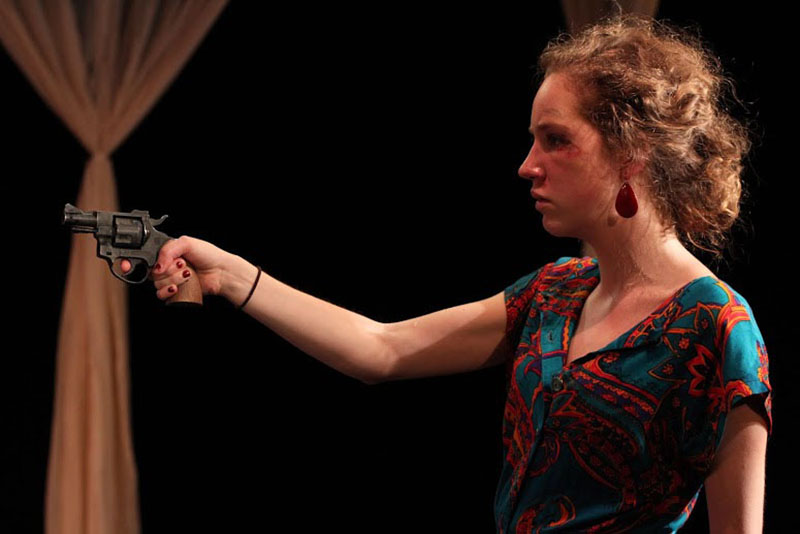‘Death and the Maiden’ Examines Insanity, Gender Roles
College junior Erin Amlicke played Paulina Salas, the troubled female protagonist in Death and the Maiden. The show ran in the Little Theater from April 10–13 and explored issues of truth and morality.
April 18, 2014
The theory of Chekhov’s gun states that in storytelling, a loaded gun should not be mentioned if it never goes off. This dramatic principle emphasizes the importance of details and their resolution — why have the gun in the first place if it’s never going to be shot? In Death and the Maiden, a play that ran at the Little Theater from April 10-13, there is a loaded gun that never goes off, both literally and metaphorically: a trial that does not get a conviction. The result was a tension-rife, suspenseful experience that left audience members poignantly unsettled.
Death and the Maiden, directed by College senior Sophie Weisskoff, keeps the audience guessing about the reliability of its characters. For most of the play, Paulina Salas, played by College junior Erin Amlicke, seems to be mentally unstable. In her first scene, she pulls a gun from a bureau as approaching headlights illuminate her shaking hands. When her husband, civil rights lawyer Gerardo Escobar, played by College senior Anthony Watkins, enters and assures her nothing is wrong, Paulina’s trustworthiness is immediately called into question.
Further doubt is cast on Paulina’s reliability when Dr. Roberto Miranda, played by College senior Alexander Bianchi, enters the play. He picks up Gerardo when Gerardo’s car breaks down in the first scene — and Dr. Roberto’s car is the same one whose headlights frightened Paulina. Paulina eavesdrops on Roberto and Gerardo’s genial conversation, and to Paulina’s horror, Gerardo asks Roberto to spend the night, given the late hour. Paulina then creeps into Roberto’s room, knocks him out, binds him to a chair and gags him. Paulina’s motivation for her violent actions is still obscured, and any doubts of her insanity are eliminated. She must be crazy.
Quickly, though, as Roberto begins to seem questionable, Paulina’s actions seem more and more justified. According to Paulina, Dr. Roberto was among the men who blindfolded, tortured and raped her under the country’s previous regime, which explains her violent actions toward him. Nonetheless, her evidence is insufficient for Gerardo. She recognizes Dr. Roberto, not by sight, but by the sound of his voice and the smell of his skin. Gerardo, and the viewing audience, are then placed in the jury’s position. Is Dr. Roberto really as innocent as he claims? Or are Paulina’s accusations true?
The brilliant thing about Death and the Maiden is that the metaphorical gun is never fired; they never resolve the main conflict. In the final scene, Paulina, Gerardo and Dr. Roberto are sitting at a Schubert concert as the piece Death and the Maiden edges towards its climax. As the lights fade and the music builds, Dr. Roberto stares unwaveringly at Paulina, the graphic description of his supposed crimes still lingering in the air. Did he do it? The audience will never know, just as Paulina will never get peace for the horrendous abuse she endured.
It’s a complicated, dark and brilliant play, and much of it relies on the actors alternately persuading the audience of their guilt, innocence, trustworthiness and dishonesty. The way Watkins touched Amlicke, the way Amlicke shook when she held the gun, the way the two danced around each other in a tense game of lies and truth made for an immersive and intense experience. Even Bianchi, who spent much of the play sitting in a chair, was both terribly creepy and tragically innocent. It was a meticulously directed and well-acted rendition of an ambitious play.
Perhaps what was most exciting, as evoked by the play’s well-executed production, was the idea of female trustworthiness and the slippery slope women can be subjected to with the use of the adjective “crazy.” At the play’s beginning, Paulina seems completely irrational, in need of medication and some serious handholding by her husband. The audience is inclined to write her off as the needy wife whose dark history interferes with her husband’s political ambitions. When she is hostile toward Dr. Roberto, a likeable doctor introduced as Gerardo’s car-trouble savior, she is further forced into the “crazy lady” box so often associated with emotional women.
Because she is trapped by this “irrational woman” perception, Gerardo — and the audience — are disinclined to believe her. Though she affirms the truth of her story over and over again, to the point of begging Gerardo to believe her, it just isn’t enough. And so she is pushed to the wayside, her voice silenced.
When she places a gun to Dr. Roberto’s head and threatens to shoot him unless he confesses, the men in the play start to take her a little more seriously. But even then, they decide they are going to placate her, and Gerardo and Roberto work together as the opposing team. Gerardo ends up telling Roberto exactly what he needs to confess in order to make her happy, and Roberto happily complies. Paulina is dissatisfied, despite getting the confession she wants.
This feeling of desertion and frustration was one that many audience members could relate to. Despite Paulina’s “craziness” and the audience’s inclination to discredit her, there is also a subtle sense of closeness between the viewer and Paulina. You want to believe her. You want her to be right. Combined with the unresolved ending, this empathy leaves the audience as dissatisfied with the outcome as Paulina is. But this ambiguity is necessary. Like the play’s ending, truth and morality in the real world can be just as ambiguous.

























